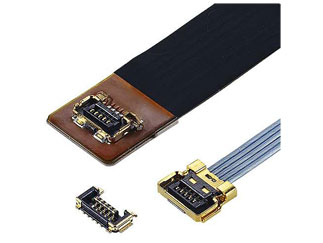

I-PEX CABLINE®-UY Connectors
Tailored to the wearables market thanks to flexibility and reliability
The CABLINE®-UY connectors by I-PEX feature one of the lowest vertical mated height and width of any micro-coax connector in the market. It is able to support coaxial cable wire sizes of AWG 40 or smaller, and discrete wire in sizes of AWG 36 or smaller, with up to 20 GHz/lane. A single CABLINE®-UY connector can connect multiple RF, low and high-speed data connections. It is ideal for wearable device applications that need an extremely small and flexible connector.
Features
| Benefits
|
CABLINE®-UY Size Comparison

CABLINE® Family
The CABLINE® family of micro-coaxial connectors are suitable for use with a variety of low-speed and high-speed communications protocols, including:
|
|
Features
| Applications
|
More Information: Wearable Devices
Wearable devices – any device worn on or attached to a user's body – make up a broad category of products, where collection of real-time data is provided to the consumer for health, fitness, entertainment, and everyday use. The medical and fitness markets have seen the biggest benefit from wearable technology as the consumer's desire to understand their current vitals is leading to healthier habits to improve longevity of life.
Consumers wearing smart devices can measure information such as blood pressure and heart rate, and can monitor for physical strain or seizures in real time. Other wearable devices improve the consumers daily interaction with the real world via visual displays (AR/VR) and near field communication (NFC) (e.g., smart watch payments). Secure wearables are allowing employees access to secure data and areas, while fashion wearables are monitoring sensors on the body to automatically cool or heat the wearer.
Designing wearable devices poses a significant challenge for engineers, who must focus on achieving comfort and reliability. This involves connecting numerous sensor devices to the electronic brains of the wearable device while ensuring compliance with prerequisites such as low signal loss and heightened mechanical flexibility.


